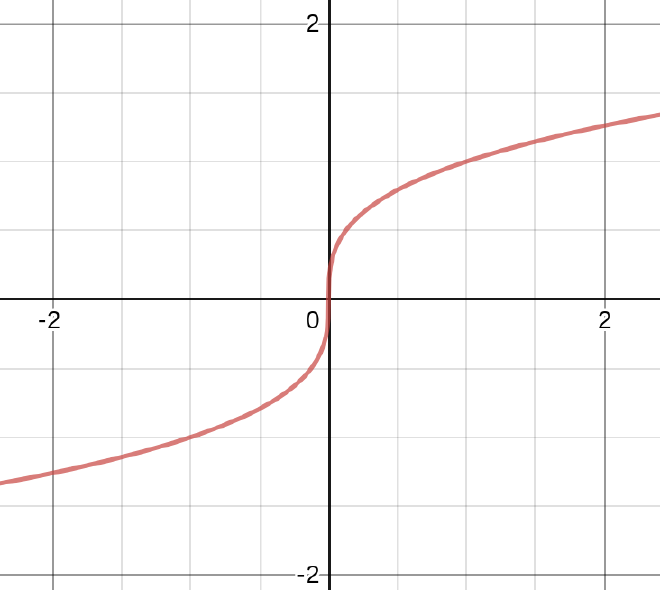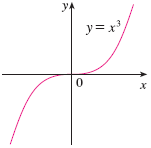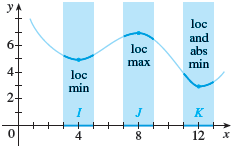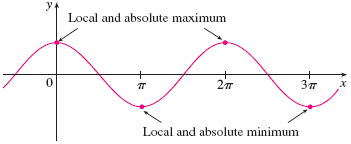Section 3.1
Table of Contents
Critical Numbers, Max and Mins
Critical Numbers #
Definition A critical number of a function $f$ is a number $c$ in the domain of $f$ such that $f’(c) = 0$ or $f’(c)$ does not exist.
Example #
Find all critical numbers of the function $f(x) = x^{3/5}(4-x)$.
Why are these critical? #
When $f’(c) = 0$, that means that the function $f$ has a horizontal tangent line at the point $x=c$. That is, it’s either a peak or a valley of the graph of $f$.
When $f’(c)$ is undefined, that means that the function $f$ has a vertical tangent line at the point $x=c$. As we’ll see in coming sections, this means the function is changing shape at that point as well.
Example #
Find critical numbers of the function $f(x) = x^{1/3}$.
Solution Since $f’(x) = \frac{1}{3} x^{-2/3} = \frac{1}{2x^{2/3}}$ (use the power rule), we can see that $x=0$ makes the derivative undefined. That means $x=0$ is a critical number.
Now let’s look at the shape of the graph $y=x^{1/3}$. Notice that the function has a vertical tangent line at $x=0$ and how the function goes from being curved up like a cup ◡ on the interval $(-\infty, 0)$ to being curved down like a frown ◠ from $(0,\infty)$:

… this has everything to do with the critical number, as we’ll see when we discuss concavity in a future section!
Maximum and Minimum Values (Extrema) #
Note that the plural of maximum is maxima, the plural of minimum is minima, and when we want to talk about multiple extreme (max/min, not 🤘) values, we’ll call them extrema.
Absolute Max / Absolute Min #
The number $f(c)$ is a:
-
absolute maximum value of $f$ if $f(c) \ge f(x)$ for all $x$ in the domain.
This is the highest possible point of the graph.
-
absolute minimum value of $f$ if $f(c) \le f(x)$ for all $x$ in the domain.
This is a lowest possible point of the graph.
Note that there may be only one absolute maximum / absolute minimum. It’s also possible that a function not have an absolute max/min.
For example, $y=x^2$ has an absolute minimum value of 0 at $x=0$, but it has no absolute maximum.

On the other hand, $y=x^3$ has no minimum or maximum values.

Local Max / Local Min #
The number $f(c)$ is a:
-
local maximum value of $f$ if $f(c) \ge f(x)$ when $x$ is near $c$.
This is a “peak” of the graph.
-
local minimum value of $f$ if $f(c) \le f(x)$ when $x$ is near $c$.
This is a “valley” of the graph.
There can be more than one local extreme value.
Some examples #
Here’s an example graph showing a function which has multiple local minimum values: one at $x=4$ with output value 5, one at $x=12$ with output value 3.
It has one local maximum at $x=8$ with output value $x=6$.
It has no absolute maximum, but it does have an absolute minimum at $x=12$ with minimum value $3$.

Here’s another graph demonstrating the $\cos x$ has local maxima for every multiple of $2\pi$: $0, \pm 2\pi, \pm 4\pi, \dots$ and local minima for every odd multiple of $\pi$: $\pm \pi, \pm 3\pi, \pm 5\pi, \dots$. Because these are also the highest and lowest points the graph ever attains, they are also absolute extrema.

The Extreme Value Theorem #
If $f$ is continuous on a closed interval $[a, b]$, then $f$ attains an absolute maximum value $f(c)$ and an absolute minimum value $f(d)$ at some numbers $c$ and $d$ in the interval $[a, b]$.
Simply put, on a closed interval, we’re guaranteed that a continuous function will attain an absolute maximum and minimum value. Because it can’t blow up to infinity, it must reach a high and a low point.
Fermat’s Theorem #
If $f$ has a local maximum or local minimum at $x=c$, then $c$ is a critical number of $f$.
Examples: #
Here are two very common examples:
-
$f(x) = x^2$ has a minimum value at $x=0$ the bottom of the U. Since $f’(x) = 2x$ is zero when $x=0$, we see that $x=0$ is in fact a critical number of $f$.
-
$g(x) = |x|$ has a minimum value at $x=0$, the bottom of the V. Since $f’(x)$ doesn’t exist at $x=0$, we see that $x=0$ is a critical number of $f$.
“The Closed Interval Method” #
Our textbook refers to this as the “closed interval method.” We’re simply using the Extreme Value Theorem. To locate an absolute maximum or minimum of a function, we:
- Look for critical points of a function
- Find the value of the function at the critical numbers.
- Find the value of the function at the endpoints of the interval.
- Pick the biggest for the maximum and the smallest for the minimum.
A just-math example #
- Find the absolute extrema of the function on the given interval: $g\left( t \right) = 2{t^3} + 3{t^2} - 12t + 4\hspace{0.25in}{\mbox{on}}\hspace{0.25in}\left[ { - 4,2} \right]$
- Find the absolute extrema of the function on the given interval: $g\left( t \right) = 2{t^3} + 3{t^2} - 12t + 4\hspace{0.25in}{\mbox{on}}\hspace{0.25in}\left[ { 0,2} \right]$
A physics example #
Between $0^\circ$ C and $30^\circ$ C, the volume $V$ (in cubic centimeters) of 1kg of water at a temperature $T$ is given approximately by the formula $$ V = 999.87 - 0.06426T + 0.0085043T^2 - 0.000679T^3 $$ Find the temperature at which water has its maximum density.
Note This says at temperature $T=0$, which is freezing, the volume of 1kg of water is approximately 999.87 cubic centimeters or basically 1 liter. That’s so cool and makes you wish we used the metric system like everyone else1 🙄
Note 2: This is a very slowly changing function on that interval. You can see the graph on Desmos by clicking this link: https://www.desmos.com/calculator/5uummrxtns
Okay, let’s solve the problem! I’m going to say “Using WolframAlpha” many times below. Click that link to take you to the actual calculation and see the results.
-
Start by finding the derivative: $V’(T) = -0.0002037 T^2 + 0.0170086 T - 0.06426$.
-
Find critical numbers: $V’(T)$ is a polynomial, so it’s always defined. And using WolframAlpha, we find that $V’(T)$ occurs when: $$ T\approx 3.96651 \text{ and } T \approx 79.5318 $$ Since only $T \approx 3.96651$ is in the interval $[0, 30]$, this is the only one we’ll consider.
-
Now, use the critical number and endpoints to find the volume of the water. $V(0) = 999.87$ cubic centimeters. $V(30) \approx 1003.76$ cubic centimeters ( again using WolframAlpha), and finally $V(3.96651) \approx 999.745$ cubic centimeters (if you’re not using WolframAlpha yet for these calculations, please do).
-
Finally, we need to interpret our answer. We were asked to find the temperature at which water has its maximum density. Density is inversely proportional to volume: $\text{Density} = \dfrac{\text{mass}}{\text{volume}}$ So we the maximum density will occur at the minimum volume.
💥 Water has the minimum density when the temperature is approximately $3.96651^\circ$ C. 🤯
-
Except Myanmar and Liberia. Literally the rest of the world. ↩︎